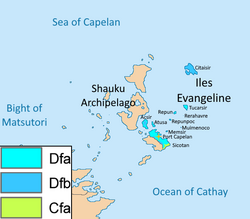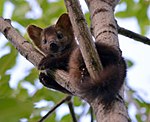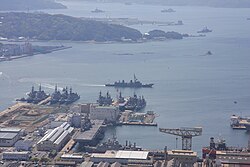Iles Evangeline
This article is a work-in-progress because it is incomplete and pending further input from an author. Note: The contents of this article are not considered canonical and may be inaccurate. Please comment on this article's talk page to share your input, comments and questions. |
Iles Evangeline | |
|---|---|
Military Directorate | |
| Etymology: Named for Crown Princess Amelia | |
| Nickname(s): | |
| Motto(s): "I have returned" | |
 Map of Iles Evangeline and its climate classifications | |
| Candidate Jurisdiction for BORA Inclusion | |
| Capital | Port Capelan |
| Government | |
| • Type | Pre-democratic military governorate |
| • Body | Council of Colonels |
| • Prefect Plenipotentiary | Rachelle-Evangeliste Vanchamps d'Elisioile |
| Area | |
| • Total | 34,887.14 km2 (13,470.00 sq mi) |
| Population (2026) | |
| • Total | 1,485,556 |
Iles Evangeline, officially the Candidate Jurisdiction for BORA Inclusion of Iles Evangeline is a territory of Burgundie. Previously owned by Varshan which governed it as part of its Shauku Islands Province until its forces were expelled in 2021 by a joint Corummese-Alstinian invasion after which it was transferred to Corummese control befor being sold to Burgundie oin YEAR.
Geography
Geology
The Iles Evangeline make up the northeastern cluster of islands in the Shauku Archipelago main island that is divided between Sotsial and Iles Evangeline is
- Citaisir: highest island, northern most island
- Tucarsir: seal island
- Repun: the offshore
- Rerahavre: wind harbor
- Repunpoc: the lower offshore
- Muimenoco: winnowing woman
- Memsir: the island of springs
- Atusa: the naked one
- Acsir: little brother island
- Sicotan: Pleasant village, main island
Climate
- Citaisir: Dfb: Humid continental climate, warm summer
- Tucarsir: Dfa: Humid continental climate, hot summer
- Repun: Dfa: Humid continental climate, hot summer
- Rerahavre: Dfa: Humid continental climate, hot summer
- Repunpoc: Dfa: Humid continental climate, hot summer
- Muimenoco: Dfa: Humid continental climate, hot summer
- Memsir: Dfa: Humid continental climate, hot summer
- Atusa: Dfa: Humid continental climate, hot summer
- Acsir: Dfa: Humid continental climate, hot summer and Dfb:Humid continental climate, warm summer
- Sicotan: Dfa: Humid continental climate, hot summer, Dfb:Humid continental climate, warm summer, and Cfa: Humid subtropical climate
Flora and fauna
Notable flora and fauna Name Type Picture Notes Ussuri brown bear Fauna 
One of the largest populations by average size of brown bears (Ursus arctos lasiotus) Steller's sea eagle Fauna 
On average, the heaviest eagle species in the world (Haliaeetus pelagicus) Yezo sika deer Fauna 
Large subspecies of the sika deer (Cervus nippon yesoensis) Ezoris Fauna 
Also called the Ezo squirrel (Sciurus vulgaris orientis) Ezo red fox Fauna 
Native to northern Japanese archipelago (Vulpes vulpes schrencki) Ezo tanuki Fauna 
Subspecies of raccoon dog native to Hokkaido (Nyctereutes viverrinus albus) Hokkaido dog Fauna 
A Spitz-type domesticated hunting dog perhaps descend from introduced Akitas Dosanko Fauna 
Also called the "Hokkaido horse" Sable Fauna 
(Martes zibellina) A species of marten which inhabits Hokkaido and Northern Asia. Viviparous lizard Fauna 
(Zootoca vivipara) Ezo salamander Fauna (Hynobius retardatus) Dolly Varden trout Fauna 
(Salvelinus malma) Sasakia charonda Fauna 
National butterfly of Japan (ō-murasaki, "great purple") Grey Heron Fauna 
(Ardea cinerea) Long legged wading bird. Chum salmon Fauna 
(white salmon (白鮭 シロサケ) is native to middle and northern Honshu, Hokkaido and the North Pacific. Sockeye salmon Fauna 
(Oncorhynchus nerka, ベニザケ - Benizake) live in Hokkaido and the North Pacific. Ezo spruce Flora Picea jezoensis Sakhalin spruce Flora Picea glehnii Japanese rose Flora Rosa rugosa
History
Early Oyashima settlement
Light Oyashiman settlement since roughly 200 BC
Burgoignesc colonial rule
Main article: Oyashima#Early_modern_era
Varshan conquest
Conquest in the 1850's during Tezomoc expedition by Varshan, naval victory over Republic of Mutsutori makes continued hold of islands unfeasible
Corummese military rule
A joint naval invasion by Alstinian and Corummese forces pushed Varshan's forces from the islands and brought an end to its rule there. A period of popular resistance driven by Arzalist priests followed. The Corummese military enacted brutal mass reprisals and deportations that however succeded in quieting down the situation. Civilian varshani administrators were summarily dismissed, Arzalist shrines shuttered and all public gatherings of over three people prohibited. Whatever produce was imported from the mainland was requisitioned by the army to supplement its rations, the locals were introduced to a new diet consisting of disgusting aspic food rations courtesy of Agario. Four months after introduction, there was a riot at a food distribution center in which twenty tons of aspic rations were set on fire. Corummese rule of the unruly islanders was becoming more expensive and less advantageous than previously thought.
Handover to Burgundie
Liyu, was transferred to Burgoignesc administration on day,month, YEAR as a reparation for the loss of Ayermer furing the Second Great War which until that point had remained a major sticking point in the relationship between Burgundie and Corumm to the point that both countries, as a matter of administrativia, remained technically at war until the hand over of Liyu and the sogning of the Instrument of the Formalization of the Cessation of Hostilities Stemming from the Global Conflicts of the 1930s and 1940s.
A respectful ceremony between outgoing District Chief, Gong Farbo, and incoming Prefect Plenipotentiary, Rachelle-Evangeliste Vanchamps d'Elisioile and their retinues of diplomats, marines, sailors, and administrative personnel after which its name was changed to Iles Evangeline after Crown Princess Amelia, of Burgundie who helped to broker the deal.
Government
Temporary military government due to high security challenges? Arzalist autonomy or different governing systems for different communities
Economy

The economy of the islands is relatively developed and varied as they possess significant natural resources that the Varshani state sough to develop. Iles Evangeline have significant reserves of copper and thus strip mining of these is a major economic activity with an estimated production of four hundred thousand metric tons extracted in 2021. All of Iles Evangeline's copper mines are now under the control of the Department of Trade which is introducing the use of newer technology to increase copper production. Also present are large deposits of blue limestone and diorite which were highly valued by the Varshani for use in the construction of their monuments and temple complexes. So important were these materials to the mainland that most of the mines were nationalized and placed under the direct control of state run Arzalist foundations that directed the materials specifically to temples under construction in the mainland. Another important economic activity is the cultivation of aloe vera, which is used in Varshan's traditional medicine. Under Varshan rule, almost one third of the island's arable surface is dedicated to planting aloe fields. Tourism from mainland Varshan began to experience moderate growth and a few resorts catering to the upper castes were opened in the late 2000's. The partial restoration of the Blood Fane of Buruso saw a marked uptick in arzalist pilgrimages to the site so much that the Varshan Control Commission lodged at formal complaint with Corummese authorities, fearful of arzalist proselytism. Burgundie has banned Varshani travellers all together.
Mining
copper and thus strip mining of these is a major economic activity with an estimated production of four hundred thousand metric tons extracted in 2021. All of Iles Evangeline's copper mines are now under the control of the Department of Trade which is introducing the use of newer technology to increase copper production. Also present are large deposits of blue limestone and diorite
Agriculture
Agricultural production, primarily of aloe vera, wheat, soybeans, potatoes, sugar beets, onions, pumpkins, corn, raw milk, and beef.
Aquaculture
Pisciculture
Pisciculture in the Iles Evangeline is focused mostly on the raising of chum salmon, Sockeye salmon, and Dolly Varden trout. Artisanal fishing is the only allowable form of pisciculture in Iles Evangeline and it produces about 1-200 tonnes of fish each year.
Since the Burgoignesc administration began there has been demand for investment in modernization of pisciculture across the Iles Evangeline to ramp up exports of Sockeye salmon specifically both farmed and wild caught. A team of experts are searching for suitable sites for copper alloy Template:Wpol for the sockeye.
The pisciculture sector, like all other sectors in the Iles Evangeline are severely underdeveloped in the Occidental perspective. The Burgoignesc Ministry of Economy, Finance, and the Recovery's Department of Trade and the Ministry of Agriculture and Food have established a Joint Office of Evangeline Economic Development and Food Security to identify "locally acceptable avenues to increase development and output for both local and overseas consumption".
Tourism
Tourism has currently been severly restricted as the Treaty Observation and Implementation Corps of Burgundie has set about to reconstitute the government and economy of the Iles Evangeline. But early surveys point to wintersports being a primary draw with skiing/snowboarding and dog sledding being primary activities. Thermal baths and locally brewed beer are expeted to be a strong draw for the après-ski set.
Trade
| Port Capelan | |
|---|---|
| Location | |
| Country | |
| Details | |
| Opened | YEAR |
Port Capelan is a small container port that can accommodate two feeder sized ships at once. It is used to export the agricultural goods from the island but also to supply the locals with sustenance since the island is not self-sufficient.
Trade is handled throught the Shauku Island Trading Company (SITC), a joint stock company that is owned 20% by Alstin, 20% by Burgundie, 20% by O’Shea Container Shipping, and the remaining shares are publically traded. The SITC handles the imports and exports from Iles Evangeline and Alstinian Sotsial. It runs a regular route from Equitorial Ostiecia and Deralveca City, Alstin.
Infrastructure
Maritime
There is also the Iles Evangeline-Korell ferry which makes one round trip every week with a stop at Ankae in Metzetta. Marine Highway ferry system to connect the islands together with Sotsial and Oyashima.
Roads and rail
Air
Iles Evangeline is accessible through a connecting flight from Anjiro International Airport on the Alstinian Sotsial. Capelan Regional Airport(CRA) is a state-run public airport situated in the main island, it has two runways with an asphalt surface measuring 1,524 x 46 m. For the 12 month period ending on March 13 2025,the airport had a total of 15,032 flights and an average of 18 daily flights. A new runway and renovated passenger areas are planned for 2029.
Energy and electricity
Military installations
Iles Evangeline is home to two military bases, Fort St. Genevieve, jointly operated by Navy of Burgundie and the Revenue Guard, and Fort St. Ambrose, operated by the Foreign Legion.
Fort St. Genevieve
| Fort St. Genevieve Northern Cathay Joint Maritime Patrol Station | |
|---|---|
| | |
 | |
| Site information | |
| Owner | Burgoignesc Security Forces |
| Operator | Navy of Burgundie |
| Controlled by | Burgoignesc Borealis Combined Forces Command, Western Sector |
| Condition | Operational |
| Site history | |
| Built | YEAR |
| Garrison information | |
| Occupants | Navy
|
Fort St. Ambrose
| Fort St. Ambrose Garrison of the Transitional Detachment of the Foreign Legion and National Gendarmerie in Iles Evangeline | |
|---|---|
| | |
 | |
| Site information | |
| Owner | Burgoignesc Security Forces |
| Operator | Army of Burgundie |
| Controlled by | Burgoignesc Borealis Combined Forces Command, Western Sector |
| Condition | Operational |
| Site history | |
| Built | YEAR |
| Garrison information | |
| Occupants | Foreign Legion
Treaty Observation and Implementation Corps of Burgundie
|
Demographics
Ethncity according to the official census (2020)
The demographic makeup of Iles Evangeline has changed considerable over the years. Originally lightly settled by peoples from Oyashima since around the year 200 CE, the islands never held more than a few thousands at their population peak. The disastrous aftermath of the Tezomoc Expedition for the Oyashima fleet led to an almost complete exodus from the islands, with Varshan bringing in thousands of its own laborers to work on the many mines on the islands. This demographic dominance by peoples of Varshan origin continues to the modern day, altough Corummese rule resulted in the return of some Oyashimans along with new Corummese arrivals. Corummese and Rusanan residents were offered a stipend to leave the island upon the transfer of power.
Ideas
Poop factory aka GUANO. You could make it a garbage collection island for Crona. Nature reserve is an easy one, but doesn't work great in conjunction with guano mining and garbage collection. service shipping between Corumm/Alshar and your colonies. Probably an important island for the navy You can right stuff about human migration through the islands from Alshar to Crona to Australis. Plastic surgery destination for interested Cronans You could have the Varshani history be about suppression of the native Alshari population while Varshan made irredentist claims about the islands being the gateway to Crona or something You can look to feudal Japan for other history ideas for before Varshan controlled the islands cuz yknow islands




